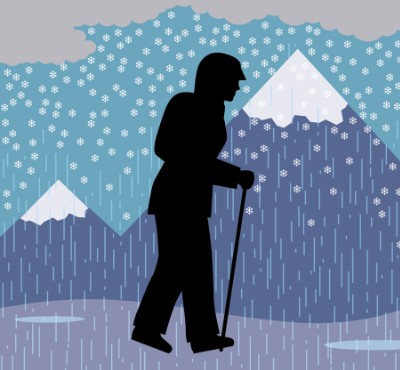Thursday 25th January 2024, 3:00pm
Garry Nicholson, Forecaster and Project Manager at Mountain Weather Information Service (MWIS) on what to expect from winter forecasting.

Winter brings the most brutal of conditions to the mountains and this season so far has been no exception. We’ve had a succession of named storms, major rainfall events, plus a notable very cold period during mid-January. In between the savage spells, we also found a period of serene beauty, as inversion conditions existed over a series of days.
Like at any time of year, our weather can be highly variable. It is almost hard to believe how much things can change in a short space of time. In winter, hazards are magnified further and the severity is often far greater. The shorter days also put a premium on finding those often short-lived windows of opportunity.
Some winter weather patterns on the hills are straightforward, others are more complex, especially when temperatures are fluctuating just around freezing point. The height to which snow falls will depend on the freezing level, humidity and the intensity of the precipitation. Snow falls lower if the air is drier, and if it falls heavier.
Snow and ice are never an outright guarantee throughout the season as mild and cold spells come and go thanks to our maritime climate.
Cycles of freeze and thaw usually occur most rapidly during changeable westerly episodes, when warm and cold fronts sweep through bringing a quick rise and fall of temperature. One moment the mountains are sub-zero to mid-elevations, the next it can be several degrees above freezing to the high tops.
To get a sustained period of freeze, we need the Atlantic weather systems to take a more southerly track, keeping us on the chillier northern flank of frontal systems. Or we need the weather pattern to become slower moving - a ‘blocked’ regime as we would call it. This can allow much colder air masses to drift our way.
Wind flows between west and north often result in showery conditions as cold air moves over the relatively warmer sea surface. These showers contain a mix of snow, hail and rain. The more unstable patterns bring a risk of isolated thunder and lightning.
Arctic northerlies can bring extremely low temperatures - we saw summit air temperature values of below -10C in mid January. However, these patterns can be relatively short lived, often switching back to less cold westerlies after just a few days.
East to north easterly airflow patterns are usually best for more sustained cold periods. Air can arrive on our shores from northern Scandinavia or at times the depths of Siberia. Dry, powdery snow is often the result, because this air has such a low humidity value. A little moisture gathered up from the North Sea is just enough to bring the flurries.
Heavy wet snow requires a finely balanced Atlantic influence. Pushing a moisture laden weather front towards us, but not so far that it lifts the temperature too much!
Just like at any other time of year, we want to see high pressure nearby to give us the best of days. These anticyclonic patterns give us scope for inversion conditions as the air slowly sinks.
If the inversion is at just the right height, our mountains can bask in spring like warm sunshine, whilst the glens or lower hills can be shivering in freezing fog. High terrain can still remain extensively frozen in these situations because the ground holds on to its own microclimate, chilling the thin layer of air nearest to the surface.
Stay up to date with conditions for your mountain area at mwis.org.uk and don’t miss the latest MWIS forecast videos on social feeds!
Do you want to know more about our fascinating weather patterns? The MWIS are providing half-day weather skills workshops at Fort William Mountain Festival over the weekend 17-18th February. Or you could have a full day of weather study at ‘A Day with MWIS’ in Edinburgh on Saturday 24th February.